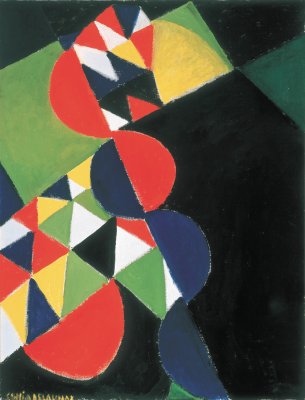About the Artist
Sonia Delaunay was exposed to music and art at a young age. While attending art classes in Germany and Paris, she met various artists, including her future husband, artist Robert Delaunay. Together Robert and Sonia pursued the study of color and cofounded the Orphism art movement. The movement combined Cubist geometric shapes with strong color. The use of color theory, inspired by writings by nineteenth-century French dye chemist Eugène Chevreul, is a major component of Delaunay’s work. Her geometric abstractions (art based on the use of geometric shapes) contained vivid color and bold pattern. In reflecting on the Orphism movement, Delaunay stated, “We disengaged color from all its foreign elements and it became a means of expression, pure like notes in music and words in poetry.”
In need of added income to support her artmaking, the artist began designing costumes for plays. She later entered the fashion business, drawing inspiration from her artwork to create clothing and textiles, and also practiced interior design. Delaunay continued with her career after her husband’s death in 1941. She even painted several famous French sports cars as accessories to her textile and clothing designs. In 1964, she became the first living female artist to have a retrospective exhibition at the Louvre.
About the Art
Colored Rhythm, 1958, consists of colorful and geometric shapes, including triangles, semicircles, and squares. These shapes are arranged in patterns along diagonal lines on a dark background. Each shape has soft edges and is slightly different. Delaunay’s use of complementary colors enhances her shapes, creating a vivid composition. According to Chevreul’s color theory, “when complementary colors are juxtaposed, each appears to be more intense than when seen in isolation.”
